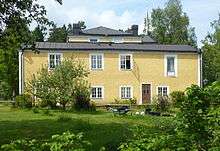Hinduism in Sweden
Out of a population of 8.9 million, persons of Indian origin and non-resident Indians together number 11,000 or 0.012%. A majority of them are Punjabis, Bengalis, Gujaratis, Telugu's, Tamilians and Kannadigas.[1]
Timeline of Arrival of Indians in Sweden
Some Indian students who went to Sweden in the 1950s settled down there.
Another stream of Indians came from Uganda in the 1970s.
Some Indians sought and obtained political asylum after 1984.
The Indian community is culturally very active. Different associations hold cultural functions and observe national days.[2]
Hindus in Sweden
IRF 2005 reports that there are between 7,000 and 10,000 Hindus.
Of the 10,000 Hindus, 2,000 are of Tamil Origin [3] and 1,500 are of Bengali Origin.
Hindu Organisations in Sweden
- Bengali Hindu Association
- Hindu Mandir Stockholm (Stockholm Hindu Temple)
- Hindu Union Jönköping
- Stockholm Kannada Koota
- The International Swaminarayan Satsang Organisation has a temple in Mariestad
International Society for Krishna Consciousness in Sweden
International Society for Krishna Consciousness, the Krishna movement or Hare Krishna has its roots in the Hindu religion but perhaps does not see itself as a part of it even if most Hindus accept the Krishna movement as a part of the Hinduism.
The Krishna movement in Sweden functions from few places in Sweden.

- Korsnäs Gård, in Botkyrka municipal in the Stockholm county , is an establishment on the countryside with a Hare Krishna temple. Korsnäs has as its main function to work with the publishing company BBT (Bhaktivedanta Book Trust) who translates the Hare Krishna books to various languages for the entire world. The original books in English was translated by Srila Prabhupada who started the movement. Srila Prabhupada visited Sweden in 1973.
- The Hare Krishna center in Stockholm runs a restaurant, a shop and a small temple.
- The Almviks gård in the south of Stockholm County is also a country side establishment with a temple. Originally this was an agricultural cooperative but has later changed into a village project combining agriculture with families living there but working elsewhere.